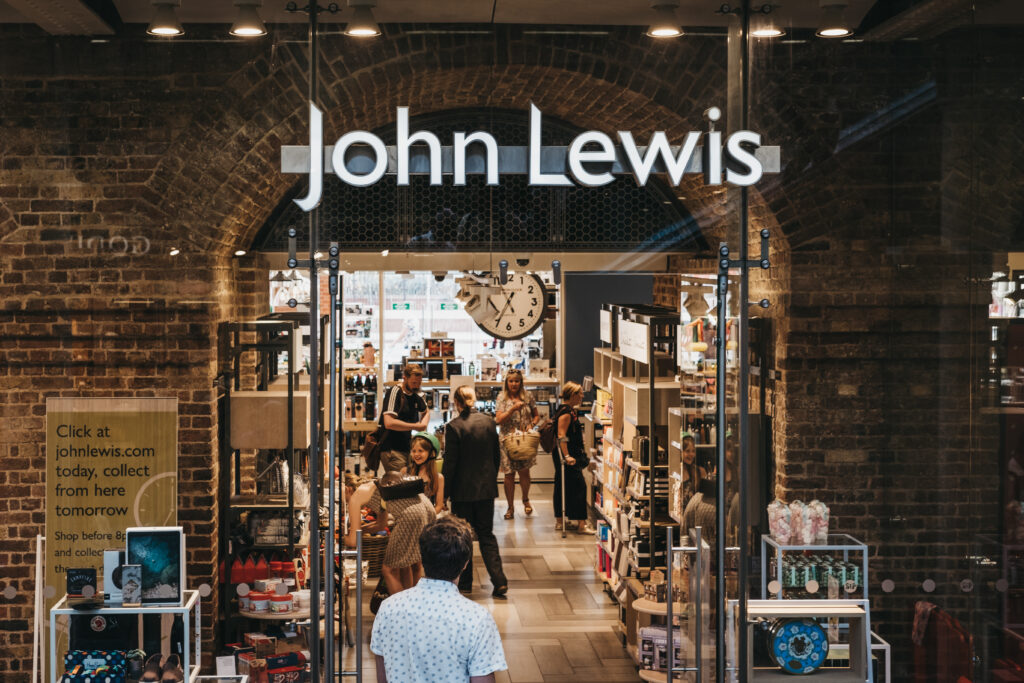John Lewis, the beloved British retailer, has become synonymous with quality, trust, and exceptional customer service for over a century. Founded in 1864 by John Spedan Lewis, the company has grown from a single drapery shop to a nationwide department store and household name. It is more of a national treasure than a brand with its traditional annual Christmas video as much a part of the holiday season as Santa Claus. But times are a changing. Last year, its well-known promise of ‘Never knowingly undersold,’ a point of differentiation since 1925, was dropped in the attempt to reinvent itself. And last week, it was mulling diluting its partnership structure, meaning it would no longer be 100% owned by its staff.
But is this the right approach?
The retail landscape has changed dramatically, and the brand has faced increasing challenges to remain competitive. The rise of e-commerce, fast fashion, and a shift in consumer preferences has had a profound impact on traditional brick-and-mortar retailers. High street stores such as Debenhams, House of Fraser, and Marks & Spencer have struggled to adapt, resulting in store closures, job losses, and financial difficulties.
Selfridges on the other hand, has focused on what it wants to become. The brand claims, “Selfridges is more than a shop. It is a landmark destination and social centre where everyone is welcome. Powered by imagination and filled with creative spirit, we invite collaboration and congregation. From our in-house cinema, restaurants and bars, skate bowl and extraordinary cultural program to our ever-evolving roster of collaborators – artists, designers, and innovative new brands – we are a creative playground in which to discover and share new ideas”. This strategy seems to be working as it has been named Best Department Store in the World four times. But John Lewis is quite a different brand from Selfridges so it must find its own future.
Meanwhile, e-commerce giants like Amazon continue to dominate the market, offering convenience and rapid delivery services that cater to increasingly impatient consumers. Amazon’s competitive prices, extensive product range, and convenient delivery options have attracted millions of customers. However, Amazon’s business model is vastly different from John Lewis’s and does not prioritise personal service or employee welfare.
Arguably, the decline started during Sir Charlie Mayfield’s tenure as Chairman. Under his leadership John Lewis underwent rapid expansion, opening 21 new stores in nine years and nearly doubling the Waitrose estate. This aggressive growth strategy aimed to increase the brand’s presence and capitalise on its strong reputation in a buoyant market. However, this expansion led to increased costs, expensive long-term leases and an oversupply of retail space coming on-stream just as the market faced unprecedented challenges from on-line retailers quickly followed by declining foot-fall due to COVID-19. The pandemic not only suppressed consumer spending but also accelerated the shift towards online shopping adding further to the brands woes.
In 2020, John Lewis appointed Dame Sharon White as its new chair, marking the first time the company has been led by someone from a non-retail background. With extensive experience in the public sector, White brought a fresh perspective to the business. As part of her strategy to revitalise the company, White unveiled plans to branch out into residential property development, aiming to create a more diversified business portfolio. Under this plan, John Lewis intends to build and rent out residential properties, with a focus on sustainability and creating communities. The properties will be furnished with John Lewis products, offering a new way for the company to showcase its offerings. Additionally, the company is considering repurposing some of its existing real estate, such as underperforming stores, into mixed-use spaces with retail, office, and residential components.

The move into property development presents new opportunities for growth and revenue generation, which could help offset challenges faced in the retail sector. It enables the company to capitalise on its expertise in home furnishings and interior design, potentially attracting customers who appreciate the brand’s aesthetic and quality. However, property development is a complex, high-risk industry that requires substantial capital investment and expertise. While the residential development strategy may offer some benefits, it is important to consider whether it aligns with the company’s core values and long-standing commitment to quality, trust, and exceptional customer service. The property sector has long held a poor reputation for indifferent customer service so by becoming a landlord, John Lewis could be the rising tide that lifts all boats. But, if it fails to align with its core values, it could tarnish the brand which has been key to John Lewis’s success for over a century. Perhaps reflecting an internal resistance to change, the Sunday Times reported that an internal poll of partners revealed that 85% of respondents did not have confidence in the company’s ability to deliver its strategy.
So, what would we advise? Well, before we advise any client, we ground ourselves in their data and thoroughly understand their situation, nevertheless, John Lewis’s core values of quality, trust, and exceptional customer service that have set it apart from its competitors for decades would prompt us to look ‘back to the future’. By returning to its roots, the retailer can leverage these advantages and differentiate itself in a crowded but increasingly impersonal market. This can be achieved in the following ways:
Prioritise Quality and Craftsmanship
By focusing on high-quality, well-crafted products, John Lewis can stand out in a market increasingly saturated with disposable, fast-fashion items. This approach will not only attract consumers seeking long-lasting, timeless pieces but also reinforce the brand’s reputation for quality and durability.
Deliver a branded customer experience
Exceptional customer service has always been at the heart of John Lewis’s success. By continuing to invest in product knowledge, staff training, and development, the company can ensure that its employees deliver personalised, knowledgeable, attentive service that gives customers a reason for coming in the first place and keeps them returning.
Take a social stance
Consumers are becoming increasingly conscious of the environmental and social impact of their purchases. By committing to ethical sourcing and sustainable practices, John Lewis can appeal to this growing consumer base and set itself apart from competitors who focus on products that are disposable in nature and questionably sourced.
Leverage the Partnership Model
John Lewis’s employee-owned partnership model has long been one of its unique selling points, fostering a sense of loyalty and pride among staff. Its purpose of ‘Working in partnership for a happier world’ has been an inspiration for its 74,000 workers and the permission for its management to take a longer-term view than corporate rivals driven by shareholder returns. By standing firm behind its purpose John Lewis can differentiate itself from competitors that have a reputation for having disengaged staff and executives driven by self-interest. Unfortunately, the brand is considering diluting its partnership model by bringing in minority investors to raise up to £2 billion. In a show-down between return on investment and delivering the purpose we know which will win.
If John Lewis were our client, we would recommend that the brand consider consolidating its retail presence by focusing on fewer, high-quality flagship stores to create a more branded John Lewis experience, one that needs to be very different from the Selfridge’s experience. By creating destination shopping experiences that showcase the best attributes of the brand, John Lewis can differentiate itself from online retailers that cannot compete with the tactile and immersive nature of in-person shopping. These flagship stores can dramatise the brand’s core values of quality, trust, and exceptional customer service while providing customers with a curated selection of products that represent the best of John Lewis as well as quality brands in pleasant, professional environment. Additionally, these flagship stores can offer value-added services such as personal shopping, interior design consultations, and exclusive events, enhancing the overall customer experience and fostering loyalty. On-line retailers and budget stores can’t begin to compete in these areas. Investing in flagship stores located in strategic, high-traffic areas will also attract destination shoppers, driving footfall and increasing sales. After all, for many people ‘going shopping’ is still a leisure activity rather than a chore even in this era of the internet. Just as importantly, by focusing on fewer, more impactful retail spaces, John Lewis can optimise its operational costs and allocate resources more effectively to the things that matter most, ensuring the long-term sustainability of its brick-and-mortar business. Yes, that will probably mean letting go some of its partners, but better that than letting go of its partnership model.
Of course, it cannot afford to ignore the march of digital shopping and so needs to have an online presence and an omni-channel approach so that customers can move between the in-store experience and personalised advice it offers but with the convenience of on-line browsing, ordering and delivery if preferred. High-Touch and High-Tech are alternative retail strategies but for John Lewis, they need to be seamless.
Whilst the brand has significant challenges and needs to find an affordable way forward, we suggest this strategy, may provide a more sustainable and customer-focused approach to retail, setting John Lewis up for continued success for the next 100 years. As Marty McFly said in ‘Back to the future’, “If you put your mind to it, you can accomplish anything.”
Shaun Smith, Smith + Co





